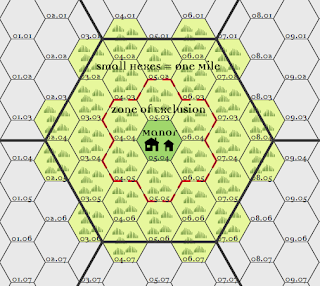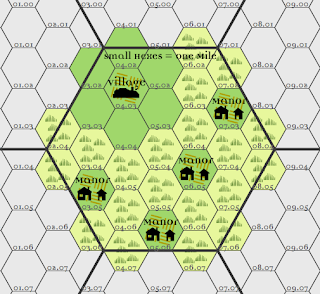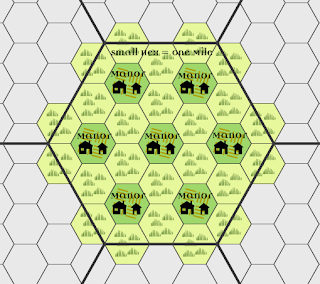This system makes two important major assumptions:
- The primary means of agricultural production is the manor house which entails open field farming with two crop rotation and communal serf labor.
- The rural to urban population ratio is 2:1. Every two farmers can feed one urban dweller.
This post focuses at the foundation levels of land use at the 1 mile hex and the 5 mile hex scale.
Each manor has a population of 100 able bodied adults and occupies one 1 mile hex. In each of the hexes surrounding it, there is a zone of exclusion in which no other settlement may occupy. Two manor's zones may overlap however. This zone represents the area in which shepherds graze animals, game is hunted and firewood is collected. All of the inhabitants are considered apart of the rural population regardless of occupation or station. Most of the population are serfs with limited personal freedoms. Each manor consists of a manor house, a small hamlet, a church, a few craft workshops such as a small smithy and a perhaps mill. It farms approximately 500 acres of land and may have a small scale mining operation on the side as well. This sort of settlement has been well described in Dungeon and Dragon terms in The Village of Hommlet.
Villages are the smallest self-sufficient urban settlements and contain the hexes' urban population. It occupies one 1 mile hex and in each of the hexes surrounding it, there is a exclusive zone of exclusion which can not be shared with any other settlement. The total population of the village is 350 able bodied adults. 100 of these villagers are engaged in the same sort of rural activities as manor populations and the other 250 villages are the hexes' urban dwellers. They urban population is engaged mostly in trade and manufacture. All of the village population are considered freemen.
Here is an example of a 5 mile hex supporting a maximum population level of 1050. 700 able-bodied adults live in this hex in 7 manors and they are able to support 350 urban dwellers in a town or city in a nearby hex:
Each town or city occupies at least one 1 mile hex and has a zone of exclusion extending for two hexes around it that can not be shared with any external settlement. Small suburban settlements may be located within the zone of exclusion but their population must be included in the total population of the main town or city. Thus, towns and cities occupy one 5 mile hex in total.
In any settlement larger than a village, the entire population is considered urban and totally reliant on imported food from the country side. Dungeons and Dragons defines towns as having populations of 1000 people or more so the smallest town would require a minimum of 21 manor houses to support its citizens. If those manors were packed together at maximum density they would require three 5 mile hexes of plains.
The next post will look at population on the 25 mile hex scale and at Birthright style provinces. Also, terrain will be consider in determining the maximum amount of arable land.
Related links:





I like it. I'm curious about the 1,050 person limitation in a 5-mile hex area, as there are several very rural parts of Europe (Hungary, central Poland, Lithuania) which don't have substantial cities but are heavily populated (more than 400 per square mile in some bits. But that is mere quibbling.
ReplyDeleteYou've got me thinking about exact mechanics for rural food supply to cities, and that is a good thing. Thank you.
Nudge. Any chance the next part will be released soon? I like what you've done so far, but is has been nearly three months since the last update...
ReplyDelete@Alexis
ReplyDeleteThat 1050 number is more of a quick abstraction for the sake of game mechanics. I'm less interested in detail on the local level and more interested in how these smaller pieces can in sum form larger provinces, which are the base land units of Birthright scale play. The purpose of this post was to lay the foundation for the long awaited part two dealing with provinces.
There are other regions of my campaign world which have population densities which vary greatly from the above rules, but these guidelines are able to describe the majority of my human inhabited lands quite nicely. I think in my notes I have some ballpark figures on wagon loads to town per manor and other exciting infrastructure details for getting the food to the cities, mostly for trying to figure out what all those city folk do for a living. There seem to be a lot in the teamsters guild.
Were those densely populated Eastern European lands using a manor system? I'm not too up on my history of that region.
Thanks for stopping by, I really enjoy your blog!
@PatrickW
Thanks for your interest! I actually wrote the first draft of part two at the same time (then became very, very busy with work) so I can post it after an editorial pass. I'll see if I can dig it up and get it posted tonight if it doesn't require too much work.
Cheers!
I realize this is an old post, but I have really started banging away on my setting and use your post quite alot. Question, in regards to the village being the smallest self sustaining settlement, aren't the numbers backwards? I mean, shouldn't it, assuming your original 2:1 rural to urban ratio be 250 farmers/herders to 100 town merchants/textiles?
ReplyDeleteHope you still follow this...
Best
TB
@The Bane Sorry for the delay, my new(ish) job has been keeping me busy.
ReplyDeleteYou did indeed catch an error. However, the number are correct, it's the description that is wrong. The village shoudn't be called 'self sustaining' as it's population depends on the economic input of four nearby manors. Each of the nearby manor with their populations of 100 farmers each can support 50 urban dwellers. The village has 100 farmers of its own and can support 50 of it's own urban dwellers. The other 200 urban dwellers of the village are support by trade with the manors. Thus, the third figure showing one village and four manors illustrates the smallest self-contained urban population. Thanks for pointing that out, I'll correct my post right away.
Also, I'm very happy you find this system useful! Thanks for commenting, it made my day! I hope you campaign is going well.
I appreciate your response. Realizing that this is a feudal medieval setup, I see where I made the mistake. I think I should/will be using both this and my original interpretation. Where I would us the above for 'civilized' areas and then the stand-alone interpretation for 'borderlands'. Awesome stuff by-the-way. Hope to see more as time permits.
ReplyDeleteBest,
TB
ummmmmmmmmmm
ReplyDelete